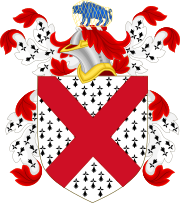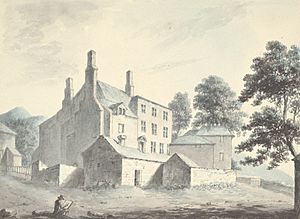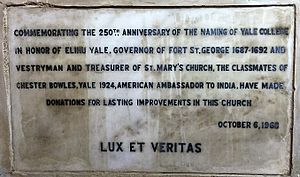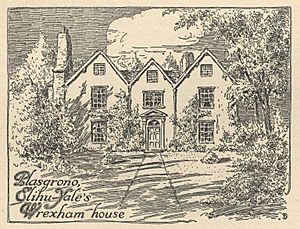Elihu Yale facts for kids
Quick facts for kids
Elihu Yale
|
|
|---|---|
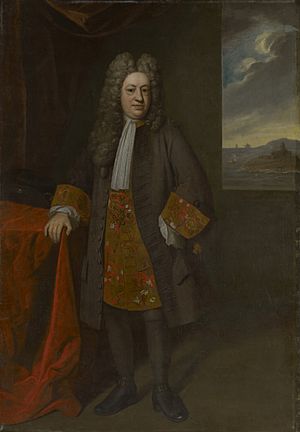 |
|
| President of Fort St. George | |
| In office 25 July 1687 – 3 October 1692 |
|
| Preceded by | William Gyfford |
| Succeeded by | Nathaniel Higginson |
| In office 8 August 1684 – 26 January 1685 |
|
| Preceded by | William Gyfford (Agent) |
| Succeeded by | William Gyfford |
| Personal details | |
| Born | 5 April 1649 Boston, Colony of Massachusetts, British America |
| Died | 8 July 1721 (aged 72) London, England |
| Signature | |
Elihu Yale (born April 5, 1649 – died July 8, 1721) was a British-American businessman and a person who helps others (philanthropist). He was born in Boston, Massachusetts, but only lived in America as a young child. He spent most of his life in England, Wales, and India.
Elihu Yale started as a clerk for the powerful East India Company. He eventually became the leader (President) of their trading post in Fort St. George, Madras, India. He later lost this job due to claims of unfair business dealings.
In 1699, he returned to Britain with a large fortune. He had earned much of it by selling diamonds. He then used his wealth to support good causes and collect art. He is best known for being a major helper of Yale College. This school was later named in his honor after he gave them many books and other valuable items.
Contents
Early Life
Elihu Yale was born in Boston, Massachusetts. His parents were David Yale, a rich merchant, and Ursula Knight. His grandfather, Theophilus Eaton, helped start two of the original Thirteen Colonies in America.
When Elihu was three years old, his family moved back to London, England. He never returned to America after that. He likely lived through big events in London, like the Great Plague of London and the Great Fire of London.
Working for the East India Company
In 1670, at age 21, Elihu Yale started working for the East India Company. This was a very powerful British company that traded goods from India. He began as a clerk in their London office. His father's business connections might have helped him get this job.
The next year, Yale was chosen as one of twenty "Writers" to work in India. He served the East India Company for 20 years. In 1684, he became the first president of Fort St. George. This was the company's main trading post in Madras, India. He played a key role in building the Government General Hospital there.
Yale became very wealthy while working for the company. He made a lot of money through secret deals with local merchants. These deals went against the company's rules. By 1692, he was removed from his position as governor. This was because he often ignored company rules and made too much money unfairly.
Leading Madras
Elihu Yale was put back in charge of Fort St George on July 26, 1687. He worked to get control of the town of Santhome for the English. His efforts were successful, and the English gained control of lands near St Thomas Mount for three years.
In 1688, the Mughal Empire took over the nearby state of Golconda. The Mughal Emperor Aurangzeb asked the English in Madras to recognize his rule. The English agreed. Aurangzeb promised Madras would stay independent. In return, he asked for English soldiers if there was a war.
During Yale's time as president, a plan was made to create a city government in Madras. This idea came from Josiah Child, the head of the East India Company. A special paper (charter) from King James II of England created the Corporation of Madras in 1687. This new government included a Mayor and other officials.
In 1689, French ships tried to attack the English and Dutch in the East Indies. They were not successful and eventually left. During this time, the English also bought the town of Tegnapatnam from the Marathas.
Slave Trade Discussions
Elihu Yale had some duties related to the slave trade as president of Fort St George. Historical records show that he put rules in place to control the practice. For example, in 1688, he ordered that enslaved people be checked by judges before being sent away. It was also made illegal to transport young children.
Some historians say that Yale himself did not own enslaved people and was against the slave trade. They point out that he put limits on it. However, other historians argue that he still benefited from the trade because it was part of his job. Some records also suggest he sentenced some people to forced labor.
Back in Britain
Yale returned to Britain in 1699. He brought with him a huge fortune, worth about £200,000. Most of this money came from selling diamonds from India. He was one of the most important diamond traders in the world at that time.
He spent the rest of his life at Plas Grono, a mansion in Wrexham, Wales. He also had several homes in London. He owned a very large art collection with over 10,000 items. These included paintings, jewels, books, and more.
Elihu Yale was later chosen for an important local role in Wales. He also became a member of the famous The Royal Society in 1717.
Family Life
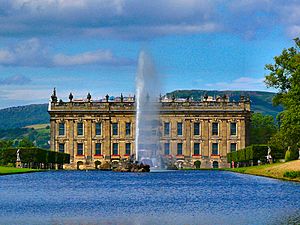
Elihu Yale married Catherine Hynmers in 1680. She was a widow and her first husband was a high-ranking official at Fort St George. Their wedding was the first one recorded at St Mary's Church in Fort St George.
They had four children together:
- David Yale, who died young.
- Katherine Yale, who married Dudley North.
- Anne Yale, who married Lord James Cavendish, a member of the important House of Cavendish family.
- Ursula Yale, who died without children.
Death
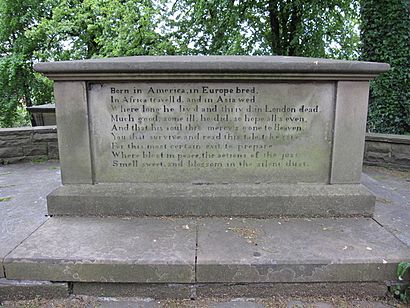
Elihu Yale passed away on July 8, 1721, in London. He was buried in the churchyard of St Giles' Church, Wrexham, in Wales. His tombstone has a poem that talks about his life:
Born in America, in Europe bred
In Africa travell'd and in Asia wed
Where long he liv'd and thriv'd; In London dead
Much good, some ill, he did; so hope all's even
And that his soul thro' mercy's gone to Heaven
You that survive and read this tale, take care
For this most certain exit to prepare
Where blest in peace, the actions of the just
Smell sweet and blossom in the silent dust.
In Boston, Massachusetts, a special marker was put up in 1927. It is near where Elihu Yale was born. It says that the college named after him is his lasting memory in his home country.
Yale University
In 1718, a man named Cotton Mather asked Elihu Yale for help. Mather represented a small school in Connecticut called the Collegiate School of Connecticut. The school needed money for a new building.
Yale sent the school 417 books, a painting of King George I of Great Britain, and nine large bundles of goods. The school sold these goods for £800. To show their thanks, the school named its new building "Yale." Eventually, the whole school became known as Yale College.
Elihu Yale was also involved with St Mary's Church at Fort St George. In 1968, on the 250th anniversary of Yale College being named, a plaque was put up at the church to remember the event.
Some people have debated how much Elihu Yale truly helped the university. An article in American Heritage magazine once called him the "most overrated philanthropist." They suggested another person, Jeremiah Dummer, gave more. However, the school's leaders did not want it to be called "Dummer College."
Images for kids
See also
In Spanish: Elihu Yale para niños


